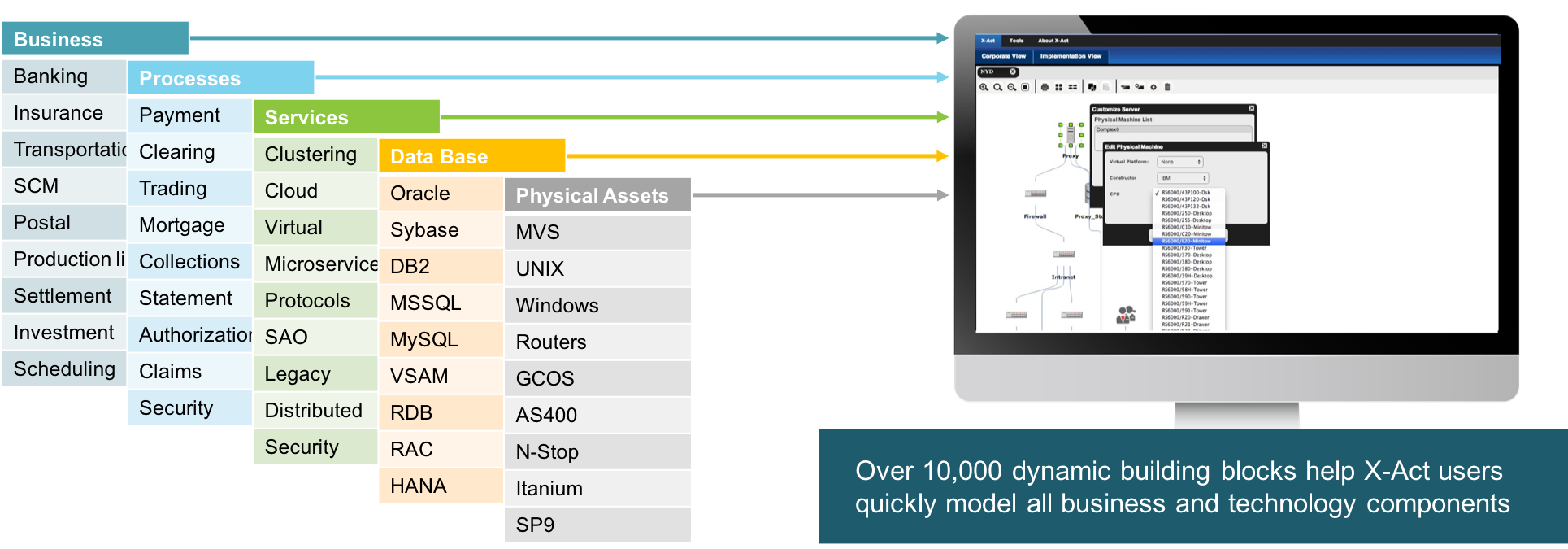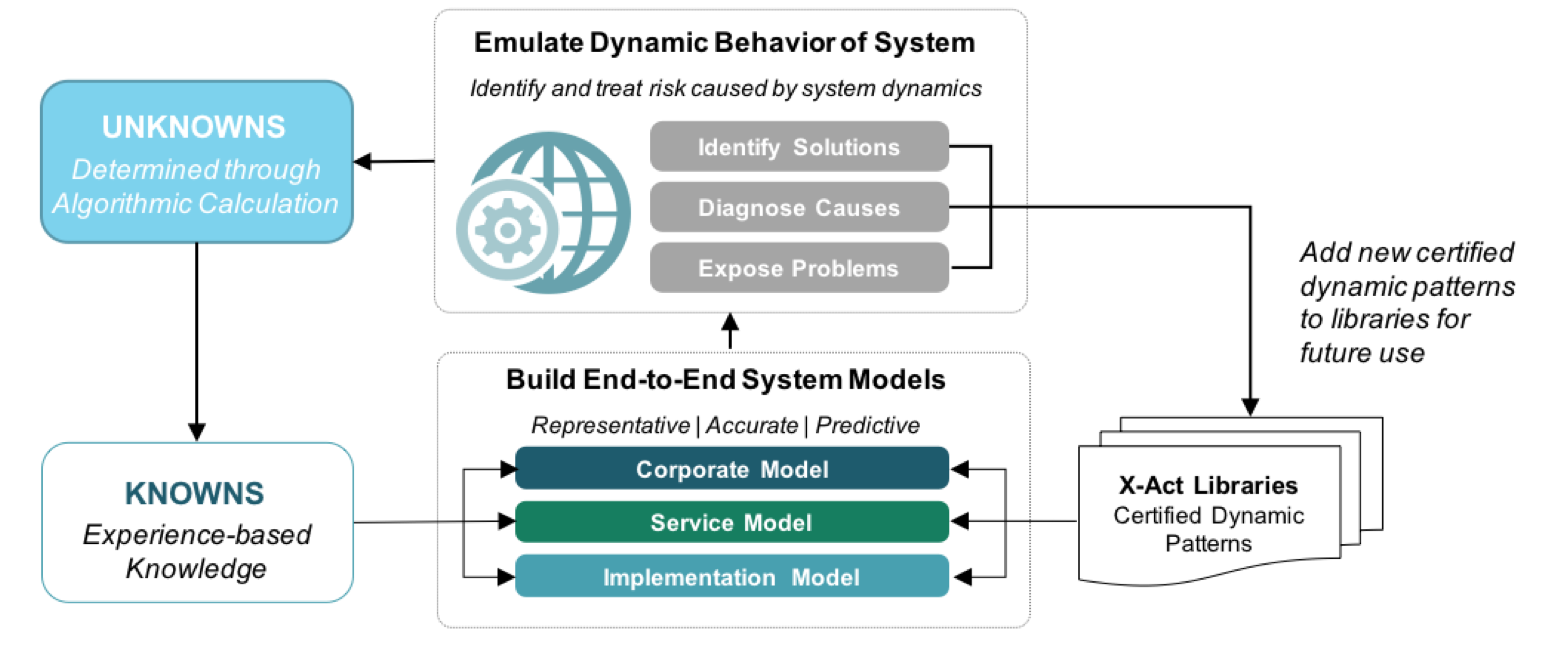Using X-ACT Libraries for Intelligent Design and Prescriptive Management of Risk
When business and IT stakeholders want to build best in class systems or ensure the optimal performance of exiting business ecosystems, mathematical emulation is an effective way to validate plans, predictively expose risks, and identify which corrective actions will achieve the desired results for any given situation.
But to gain dependable intelligence, emulations must mathematically encapsulate all the characteristics, dynamic behaviors and dependencies among each component of the ecosystem being analyzed. When the emulation adheres to all the applicable rules that govern system behaviors—whether these patterns of behaviors are known from the outset—it becomes possible to reliably predict the future behaviors of the system under any set of conditions and dynamics that may evolve. This includes conditions that have never occurred before or are believed to be highly improbable.
With this information, stakeholders can make decisions with confidence because they are able to realistically quantify the financial and operational impact of any decision and prepare for future changes that may occur for any reason—including changes outside their control, like a sharp increase in unemployment, a trade war or the introduction of a complete revolutionary technology.
X-ACT® Libraries Speed Delivery and Control Processes
A global business is an amalgamation of millions of dynamic parts and interdependencies. Manually building a mathematical model that sufficiently represents the dynamics of each component would be a monumental task. To make mathematical emulation practical for business use, X-ACT automates the steps necessary to accurately represent system dynamics and provide reliable predictive intelligence.
X-ACT libraries are a critical asset that shortens the time to value of an X-ACT deployment from months to weeks and allow businesses to benchmark their systems against best in class implementations, gain a forward-looking view of the health of interconnected systems and know when a system transformation or disruption is needed.
Every business system, whether it be a global supply chain, payment settlement system or manufacturing production line, has some characteristics that make the system unique, but in large part the system is built using common building blocks. X-ACT libraries contain many of these common building blocks with over 10,000 certified dynamic patterns that can be used in the same way pre-built models are used in Computer Aided Design (CAD) and Computer Aided Manufacturing (CAM) to speed the delivery of designs and control processes.
In X-ACT, a business system emulation starts at the organizational level, which is then served through the generation of processes and sub-processes, implemented though a certain logic or layout (architecture, urbanism or design), on a physical layer (factory, data center, sorting/transport configuration or economic instrumentation).
X-ACT Libraries Support End-to-End Modeling of Business and Technology Infrastructure
To build a representative model, users of X-ACT simply select dynamic patterns from the libraries that span everything from common business operating structures and technologies to specific platforms and databases.

These dynamic patterns are created from mathematical emulation of business and technology ecosystems through algorithmic models that encapsulate behaviors, dependencies, and surrounding rules for ecosystem behaviors so they can perform predictive analysis. Each model stores remedial options to support prescriptive actions for risk avoidance. They become, in effect, dynamic Legos modeling entire business ecosystems with technology and business infrastructure interdependencies.
When the modeling is complete, these “dynamic Legos” make up the X-ACT emulator. The deployed process allows users to control and manage the targeted environment, predict the eventual crisis or singularity points, and augment X-ACT libraries with their own newly discovered patterns to gradually build and support more intelligent automation.

Conclusion
Using libraries populated by the mathematical predictive platform represents a real breakthrough that alleviates many of the pains created by the traditional management, which starts with problem-analysis-diagnosis and ends with an eventual cure well beyond the point of optimal action.
As the libraries are continuously enriched by the dynamic characteristics that continuously evolve during a system’s lifetime, the knowledge contained within the libraries becomes more advanced. By continuously recording within the libraries foundational or circumstantial system changes, the predictive platform will identify any new risk, determine the diagnosis and define the remedial actions, and finally enhance the libraries with this new knowledge. Any decisions can be justified with accurate knowledge of the benefits, costs and constraints of any proposed change.
In this way, algorithms help businesses create a defendable advantage—by revealing the factors that may impact performance or limit agility and automatically retuning systems to maintain the highest level of performance and flexibility to respond to changing business dynamics.
Learn more about the benefits of X-Act libraries
The Using X-ACT Libraries for Intelligent Design and Prescriptive Management of Risk paper explains how businesses use X-ACT libraries in the same way pre-built models are used in Computer Aided Design (CAD) and Computer Aided Manufacturing (CAM) to speed the delivery of designs and control processes.


